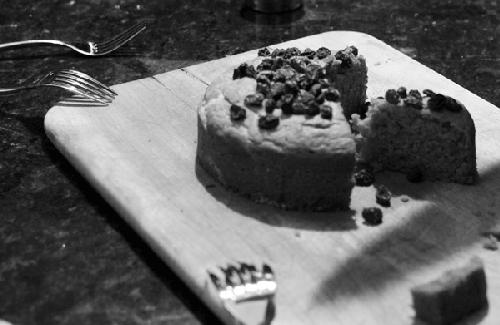2. Baking Powder
Baking powder solves the “balancing act”
problem encountered when using baking soda by including acids alongside the bicarbonates.
And since the acids are specifically mixed into baking powder, they can be optimized for
baking; you don’t have to rely on whatever acids happen to be present in the food being
made.
Baking powder, at its simplest, can be made with just one type of bicarbonate and one
type of acid. This is why, in a pinch, you can make your own baking powder: 2 parts cream
of tartar to 1 part baking soda. Cream of tartar—potassium hydrogen tartrate—will dissolve
in water, freeing tartaric acid
(C4H6O6) to react
with the sodium bicarbonate.
Commercial baking powders are a bit fancier than this, though. Different acids have
different rates of reaction and reaction temperatures, so using multiple types of acid
allows for the creation of a baking powder that’s essentially time-released. This isn’t
just clever marketing: in baked goods, if the CO2-generating
reaction occurs too slowly, you’ll end up with a dense, fallen product. And if those
reactions happen too quickly, the food won’t have time to properly set so as to be able to
hold on to the gas, resulting in things like collapsed cakes.
Note:
Some people find that baking powder made with sodium aluminum sulfate tastes more
bitter than that made with other acids, such as monocalcium phosphate.
Double-acting baking powder—this is the stuff you’ll find at the grocery store—uses
both slow- and fast-acting acids to help prevent these types of problems. Fast-acting
acids, such as tartaric acid (in cream of tartar) and monocalcium phosphate monohydrate,
can work at room temperature; slow-acting acids, such as sodium aluminum sulfate, need
heat and time to release CO2. As long as the ratio of ingredients
in your baked products is roughly correct and you’re baking within an acceptable
temperature range, baking powder is unlikely to be the culprit in failed baking
experiments.
Still, if you’re getting unexpected results with a commercial baking powder, check
whether your ingredients are highly acidic. Acidity impacts baking powder; more acidic
ingredients in a recipe will require less baking power. If that doesn’t turn up any
suspects, check how long it has been since the baking powder was opened. Even though
commercial baking powders contain cornstarch, which absorbs moisture to extend the shelf
life, the chemicals in baking powder will eventually react with each other. Standard shelf
life is about six months after being opened.
While baking powder is most commonly used in sweets, it can be used in
savory applications, too. Try making a quick-rising pizza dough—especially handy if
someone has a yeast allergy. Whisk 3–4 cups (360–480g) of flour with 1 teaspoon (6g) of salt and 2 teaspoons
(10g) of baking powder. Add 1 cup (240g) of water and knead to create a dough that has
roughly a 66–75% hydration level. Let rest for 15 minutes and then proceed with
par-baking. |
There are two broad types of cake
batters: high-ratio cakes—those that have more sugar and water
than flour (or by some definitions, just a lot of sugar)—and low-ratio
cakes—which tend to have coarser crumbs. For high-ratio cakes, there should
be more sugar than flour (by weight) and more eggs than fats (again, by weight), and
the liquid mass (eggs, milk, water) should be heavier than the
sugar.
Consider this pumpkin cake, which is a high-ratio cake (245g of pumpkin
contains 220g of water—you can look these sorts of things up in the USDA National
Nutrient Database, available online at
http://www.nal.usda.gov/fnic/foodcomp/search/).
In a mixing bowl, measure out and then mix with an electric mixer to thoroughly
combine:
1 cup (245g) pumpkin (canned, or roast and puree your
own)
1 cup (200g) sugar
¾ cup (160g) canola oil
2 large (120g) eggs
1 ½ cups (180g) flour
¼ cup (40g) raisins
2 teaspoons (5g) cinnamon
1 teaspoon (5g) baking powder
½ teaspoon (5g) baking soda
½ teaspoon (3g) salt
½ teaspoon (2g) vanilla extract
Transfer to a greased cake pan or spring form and bake in an oven preheated to 350°F
/ 175°C until a toothpick comes out dry, about 20 minutes.
Notes
Try adding dried pears soaked in brandy. You can also hold back some
of the raisins and sprinkle them on top.
One nice thing about high-ratio cakes is that they don’t have much
gluten, so they won’t turn out like bread, even with excessive beating. With a
total weight of 920 grams, of which only roughly 20 grams is gluten, there just
isn’t enough gluten present in this cake to give it a bread-like texture. There’s
also a fair amount of both sugar and fats to interfere with gluten
development.
If you’re making a quick cake like this pumpkin cake as the finale to
an informal dinner party, try serving it directly on a single plate or even a
cutting board. Besides lending a pleasant casual feel, this’ll mean fewer dishes
to wash!
